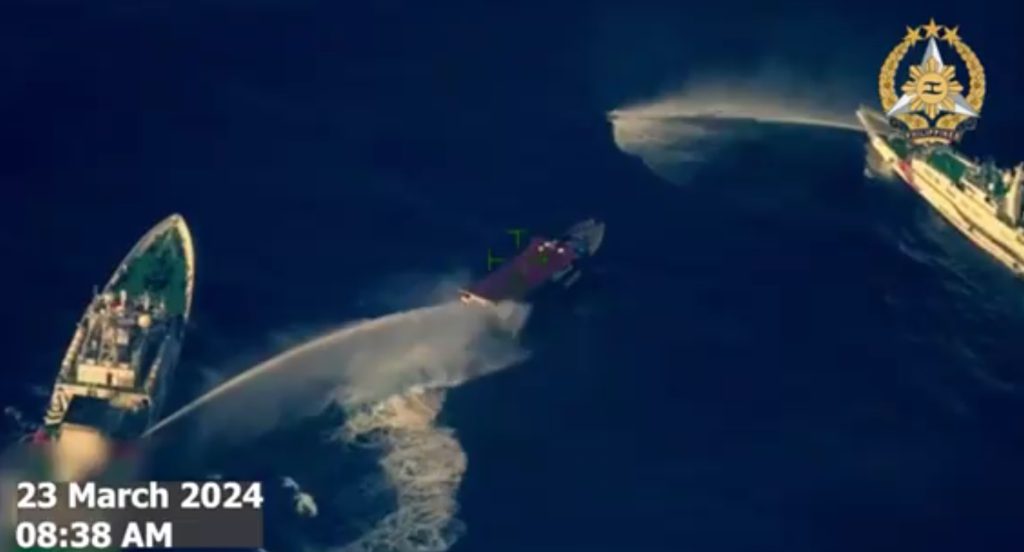US warns of Chinese military build-up in the region

Two Chinese Coast Guard vessels attack Philippine resupply ship Unaizah May 4 on its way to BRP Sierra Madre. Still taken from the Armed Forces of the Philippines
By Manuel Mogato | Date 04-07-2024
MANILA — Testifying in the US Congress for the last time before he hangs up his naval uniform, US Indo-Pacific commander Admiral John Aquilino has warned of China’s ambitions to expand its global military influence in the Indo-Pacific area and other parts of the world.
Aquilino has also predicted China may invade Taiwan in three years, by 2027, the 100th anniversary of the founding of the People’s Liberation Army (PLA).
“All indications point to the PLA meeting President Xi Jinping’s directive to be ready to invade Taiwan by 2027,” Aquilino said at a March 20 congressional hearing.
“Furthermore, the PLA’s actions indicate their ability to meet Xi’s preferred timeline to unify Taiwan with mainland China by force if directed.”
Despite Beijing’s slowing economic growth and crumbling property sector, Aquilino said China has not let up its military buildup, modernization, and coercive gray-zone operations.
The four-star flag officer said China “remains the only US competitor with the military strength, will, and intent to change the world order with authoritarian characteristics and displace the Free and Open Indo-Pacific.”
Beijing has been attempting to elevate itself to be the world’s “indispensable power” and to “alter the international system to one that encourages repressive, authoritarian governance and protectionist economic practices that distort markets by avoiding openness and transparency.”
China’s aggressive military buildup, Aquilino said, aims to supplant United States security leadership in the region, “subjugate Taiwan, exert control over the South China Sea through its excessive maritime claims, and oppress those who believe in a free and open Indo-Pacific.”
While China’s military focuses on regional issues, the Indo-Pacific Command chief said, “Beijing is setting the stage for a more significant global role through its global society, civilization, and development initiatives.”
He told the US Congress that China’s defense budget grew by 16 percent from $192 billion to $223.5 billion despite financial constraints during the pandemic.
In the last three years, at least 400 fourth and fifth-generation fighter aircraft have been added to China’s inventory.
Over 20 capital ships – destroyers and frigates – were added, and the number has more than doubled its inventory of ballistic and cruise missiles.
“Perhaps most concerning has been the rapid pace at which China has bolstered its nuclear arsenal, increasing its warhead inventory by well over 100% since 2020,” he added.
China has also built its first-ever nuclear-powered, guided-missile submarine and is currently developing a stealth bomber that could cover the second island chain and the western Pacific.
China’s PLA-Navy has developed faster and more capable destroyers and cruisers armed with missiles capable of reaching targets in the second island chain, threatening Guam and the Marianas and Palau islands.
China also increased its inventory of intermediate and medium-range ballistic missiles by more than 60 percent while developing longer-range capabilities, like the DF-27 ballistic missile that can hit targets beyond the second island chain.
The increase in nuclear and conventional ballistic missile capability forced Washington to walk away from its Ronald Reagan-era Intermediate-Range Nuclear Forces Treaty with the former Soviet Union in 2018.
While the US and Russia were dismantling their nuclear arsenal, China has been continuously building its own stockpile.
Former US President Donald Trump has been sounding off allies in the Indo-Pacific to host its medium-range hypersonic and ballistic missiles as a deterrence to China’s regional ambitions.
President Ferrdinand Marcos Jr. has ruled out the deployment of offensive conventional and nuclear missiles in the country. However, US and Filipino forces held integrated missile defense training under Balikatan drills.
The US has brought a few batteries of MIM104 Patriot (Phased Array Tracking Radar to Intercept on Target) surface-to-air missiles and the M142 High Mobility Artillery Rocket System (HIMARS) to test interoperability with the Israeli-made Spyder air defense surface-to-air missiles operated by the Armed Forces of the Philippines.
This year’s Balikatan iteration would showcase integrated air defense drills and a boat-sinking exercise in Ilocos Norte to test the two allies’ anti-access and area denial (A2AD) capabilities.
The Philippine military has strengthened its A2AD capability in its ten-year, two-trillion peso modernization program under the Marcos administration.
However, even if the Philippines doubled its budget to upgrade its military capability, it is still no match to China’s capabilities.
The Philippines must be prepared to defend its territory and sovereignty if China crosses the northern self-rule island.
Admiral Aquilino might be wrong. China might not be ready to invade Taiwan by 2027, risking a significant confrontation with the United States, supported by its allies like Australia, Canada, India, Japan, South Korea, and the European powers France, Germany, and the United Kingdom.
Retired Army General Mark Milley, the former chairman of the US Joint Chiefs of Staff, had disputed predictions made by the Indo-Pacific commanders about China’s planned invasion of Taiwan.
He said there might be an honest intention, but China cannot still match American military power in the region.
Tags: Security
